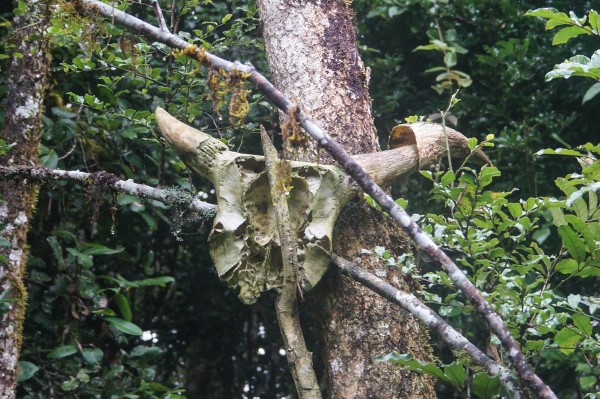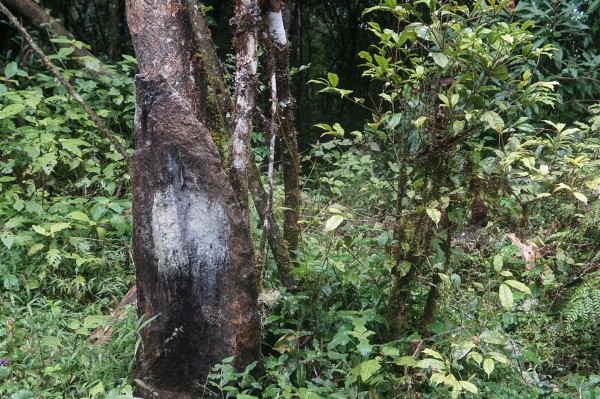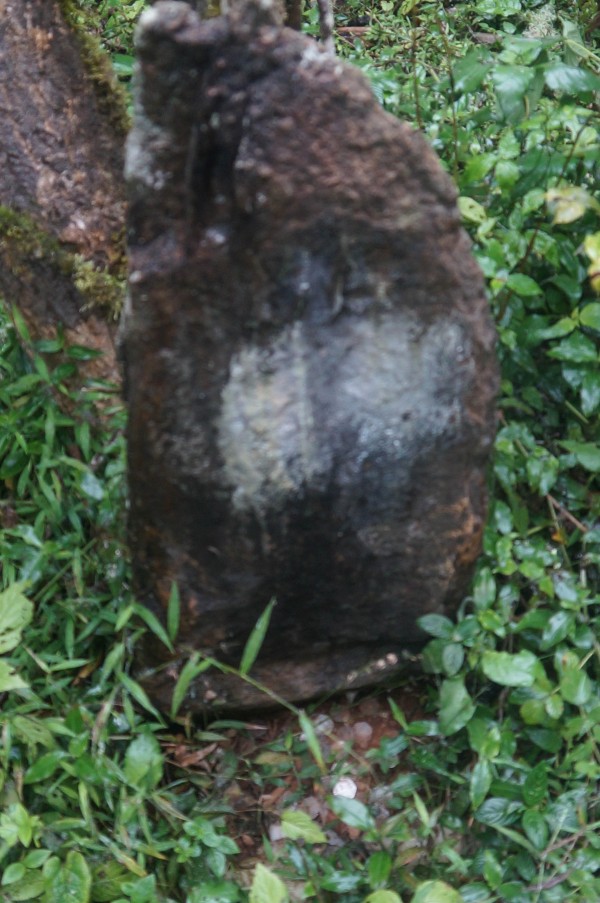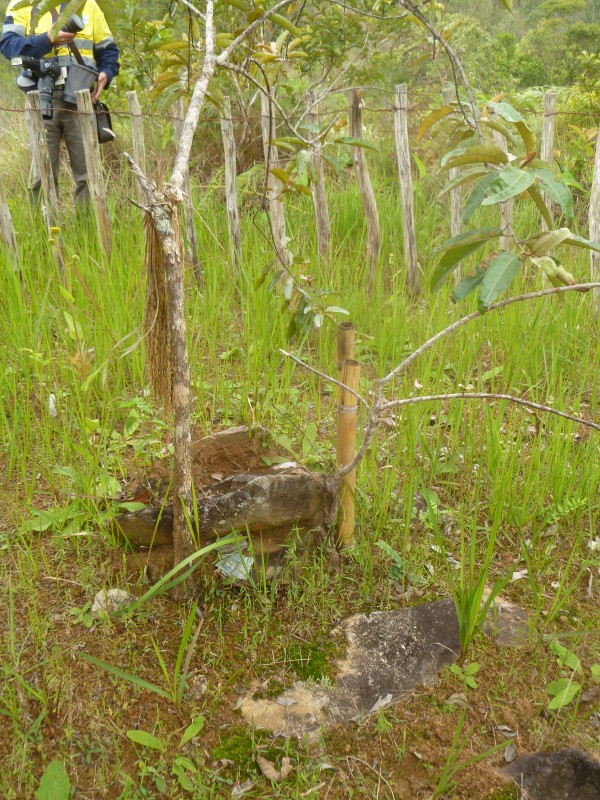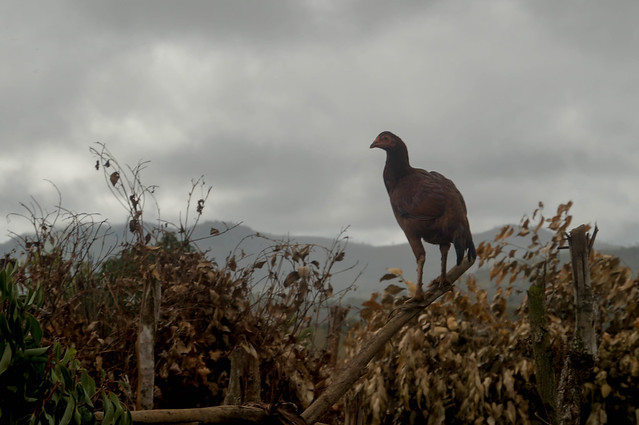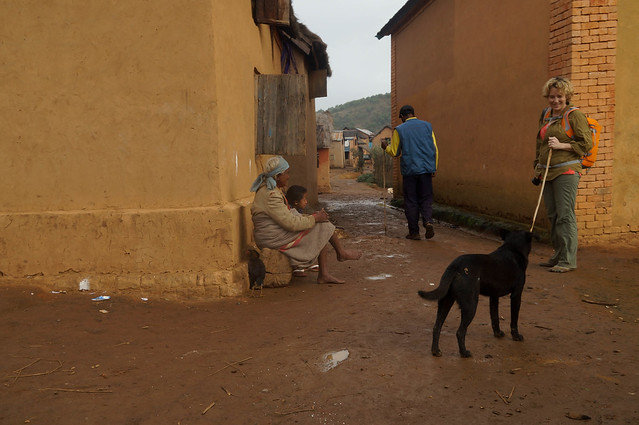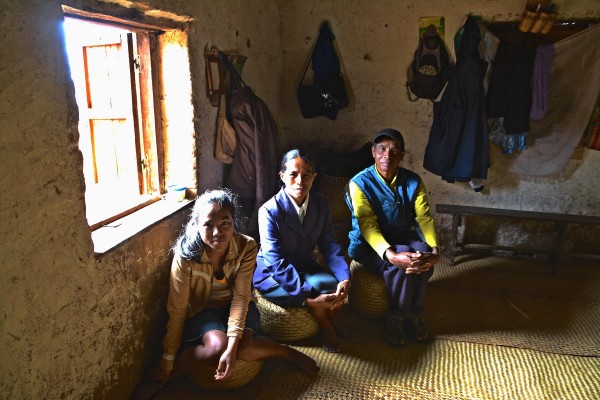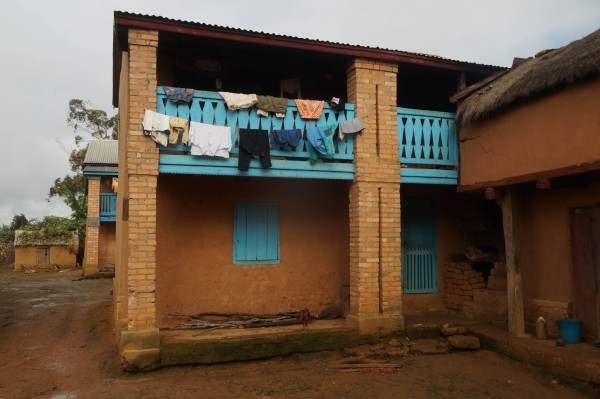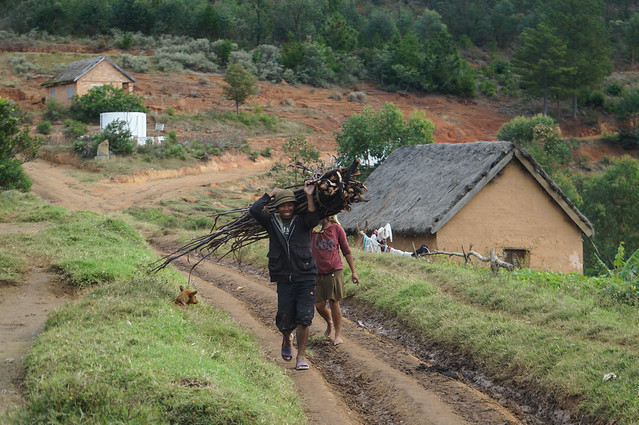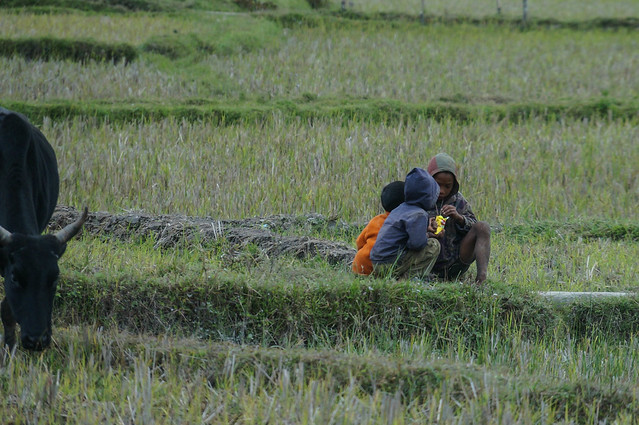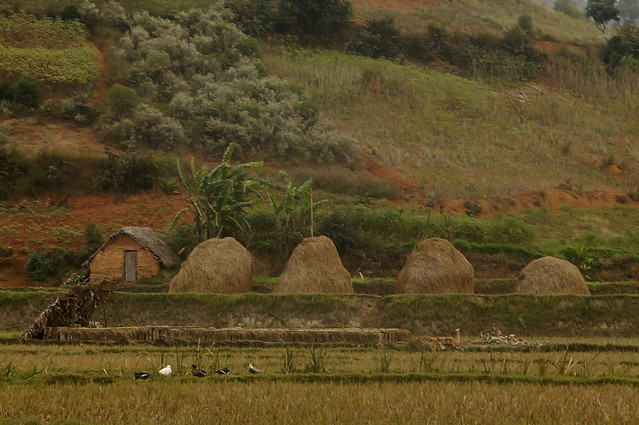As the title suggests, this is a continuation of my previous post, wherein I describe Saha Forest Camp and its surroundings…in case an orientation is needed!
We’re not serious hikers. But our local guide had done a good job so far guiding us through the rain forest, and we had nothing planned, so we decided to opt for the longest hike on offer. It would only be about 11km long, but would wind up and down the hills through the jungle, along slick clay paths through an on-and-off drizzle, eventually through grassy hills to his village, where we would visit his home, and then finally make our way through the rice paddies back to the camp, over a total of about 7 hours.
Our hike through the forest was pretty strenuous. We stopped a few times while he went to look for lemur groups known to frequent certain areas, but no luck. As we continued to climb higher and higher, we eventually came to a spot where we appeared to be crossing an earthen bridge across a deep trench, maybe 5 meters deep and 2.5 meters wide. I thought at first it was a dry creekbed, but our “bridge” would have blocked it. Our guide explained that these were defensive trenches dug by the Merina Kingdom in their war against the coastal peoples. [Few people know that the Merina Kingdom was a functioning, relatively advanced state prior to being “colonized” (defeated and occupied!) at the beginning of the 20th Century. The previous link is worth checking out to learn more.] He further explained that these defensive trenches had been dug without shovels – they had used sharp sticks to loosen the soil, which was carried away by others, and they felled trees to create a way across, and after retreating, they would push the logs into the trench.
We continued up the hill until we ended up in a small clearing. A storm had knocked a tree down across the clearing and he appeared pretty concerned. I noticed something odd in a tree in the middle of a clearing and asked – then realized it was some sort of bovine skull. “A zebu skull,” he explained.
He pointed out a couple of leafy twigs – a small brush next to a tree and told us the Malagasy name for this bush meant “light.” And the tree it was next to meant “sacred.” That’s when I noticed the 3-foot tall, flat, arrow-shaped stone standing upright directly in front of the tree.
“The people who have not converted to Christianity [most of Madagascar is Christian], they come up here and they slaughter a zebu and share it among them. This is a sacred spot, and they believe the ceremony will bring them good fortune.” I noticed a small depression in front of the stone, and saw that it was filled with coins. Offerings.
I wondered what we would have thought, had we come upon this spot on our own.
Since then, I have seen another spot like this elsewhere – protected by a small fence after it was discovered on a mine site. Apparently there are many such sacred spots in Madagascar!
After this we continued downhill, and after some time, the trees abruptly ended and we found ourselves in grassy, rolling hills. And we continued to walk.
Along the way, we talked a lot with our guide. I asked him what he had done prior to 2008, when the Camp opened. He explained that he had been a farmer, and had grown rice, and cassava, and manioc. A few cows and chickens. I asked him if the locals were able to grow enough rice and/or vegetables to sell them, and he explained that for four or five of the wealthiest families, this was possible. But for most of the locals, there was not enough land even to be self-sufficient. Land was divided equally among children, and those who had come from larger families ended up with smaller parcels, and they thus couldn’t get through the year on the rice they grew.
The people of Madagascar have traditionally used slash-and-burn cultivation – clearing small patches of forest and burning the brush, thus fertilizing the soil, and moving on after a few years to a new patch of forest. Called tavy, the process has been outlawed as no longer sustainable with a population of 24 million. However, the prohibition is difficult to enforce in remote areas. But the arrival of Saha Forest Camp had put a definitive limit on the expansion of farmland – the community now had an interest in preserving the primary forest for tourism, thus maintaining a habitat for the wildlife.
So I asked if the people who didn’t directly benefit from the camp resented the fact that they were no longer able to get what they needed from the forest – whether it was wood (over 80% of Malagasy energy is supplied from burning wood or charcoal), farmland, or even bush meat. He explained that the Camp brought money to the community – and was used to build schools, roads…all of which required workers. People who didn’t work on roads could make money planting and harvesting other peoples’ rice paddies. Women plant rice for 2500 ariary per day, and men plow the fields for 3000 ariary per day (at today’s exchange rate, one U.S. dollar is worth 3,257 ariary).
Taking into account inflation and other factors, on an individual level people feel like things have gotten tougher. But they make the sacrifice willingly because they know their children will have better education, better infrastructure, and better opportunities.
We passed some boys tending their zebu cattle, came over the crest of a hill and descended into rice paddies for the third or fourth time, slipping in the mud all the way down. Three women were doing their laundry in one of the narrow channels of water that course through the paddies. We climbed out of the valley and walked up the muddy earth road that led into a neat little village with muddy roads, filled with barefoot children, geese, chickens and probably one dog for every house. Sleepy dogs.
Our guide stopped at one of the houses and announced, “This is my home.” Right then, a woman and teenage girl walked up, dressed in their Sunday best, and barefoot. “My wife and daughter,” he explained. They had just come from church, in a village 3 miles away. He invited us into his home.
None of the homes have glass, so there are no windows, just wooden shutters. Malagasy homes are all rectangular, unlike the rest of Africa, where homes are often round. The homes in the village were all oriented in the same direction, which our guide explained, was to take advantage of the direction of the sun and the prevailing wind, which helped cool their homes. There is also a cosmological component to Malagasy architecture.
We climbed the wooden stairs to the second floor. The interior was sparse, and smelled of burnt wood from the many fires that had been built indoors during the cooler season. The sitting room was furnished with “poufs” and the floor lined with long mats. He explained that his wife had made them from rice stalks – each meter-wide mat, the length of the room, had taken a day to weave. He explained that he had two other children, but swelled with pride as he told us they were both studying at the university in Antananarivo. The money he made as a guide paid their tuition.
He explained that his house had been constructed with 30,000 bricks, made from the mud of the surrounding fields. The walls were filled in with a mixture of rice hulls, cattle dung and earth. That he and his wife had built this house together themselves. I asked if everyone built their own house and he answered yes. He then asked how our houses are constructed in the U.S. – the materials, but also whether I had built my own home. He found it curious when I explained that the average American has no idea how to build a house, or make bricks. He asked where we got our bricks and I explained that I wasn’t really sure where they came from – maybe factories – but people specialized in the building of houses took care of that and we just bought the finished product. I think he found this very strange.
As we walked through the rest of the village and snapped a few photos, the girl above started clowning for the camera. We stopped at one house where there was an odd bulge in the ground, and he paused there to draw a diagram in the mud using a stick. He described the exact dimensions of the hole that had been dug underneath, roughly in the shape of a spinning top, lined with fern and then – was it wood? – in the very bottom. I realized he was describing a septic tank of sorts – the fern somehow pulls the liquid out of the waste and siphons it to the bottom, where it is absorbed, leaving behind the solid waste. I didn’t want to ask what happens to that. But noting that nearly 90% of Malagasies lack access to a toilet, I was impressed.
One of the many characteristics Malagasies share with the Kalimantan people in Borneo, thousands of miles away and long-suspected to be the origin of many of Madagascar’s first settlers, is ancestor worship – i.e. recent ancestors are consulted for advice on important life decisions, and their avoidances often revered as fady, or taboos. So as we passed this house, our guide pointed out, “This is the traditional blue balcony” (nearly all of the balconies in his village were this shade of blue). Because I always assume there is a practical reason for things, I asked him why balconies are traditionally blue. He explained, “I don’t know why. The ancestors didn’t know why either, but they always painted their balconies blue.”
OK, that works for me.
Before we leave the village for good, here’s an aerial view. Note how all of the front doors are roughly oriented west, and the long wall of the house roughly north-south.
So the rest of our hike was pretty uneventful. The rain turned into a steady drizzle and we took the most direct route, which was over the red clay roads and through the rice paddies.
We ran into some shy boys curiously watching the two silly foreigners slipping and sliding on the muddy barriers separating the rice paddies, and Anne gave them a packet of candies. Another, older, boy came along and took it from them, and we were bummed about that. But then a few minutes later we saw them huddled together as the older boy distributed the candies between the three of them, one at a time.
We returned back to our rooms sore, muddy and exhausted. Time enough for a nap under the down comforter, until the delicious dinner that would be served in a few hours. Until then, here’s another video from some of the things we saw during our time in and around the Camp.
To see all the photos from Saha Forest Camp, click here.
To see all photos from Madagascar, click here.



